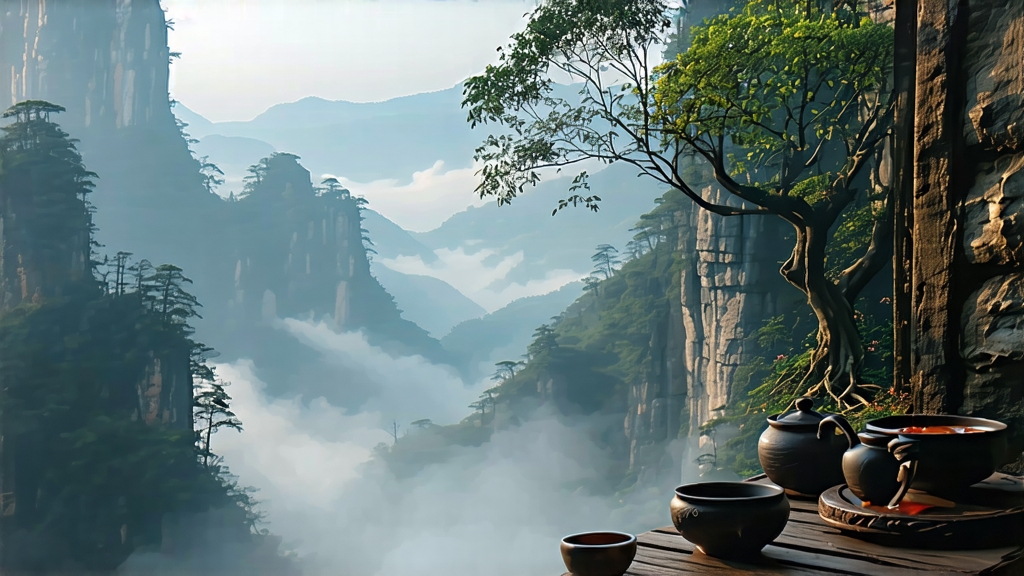
If oolong tea were a royal court, Wuyi Da Hong Pao would sit on the basalt throne. Born among the vertiginous crevices of northern Fujian’s Wuyi Mountains, this “Big Red Robe” carries the scent of pine-smoke, the sweetness of longan, and the mineral whisper of 400-million-year-old rocks. For eight centuries its name has been spoken in the same breath as imperial tribute, scholarly verse, and the soft click of Yixing clay against porcelain. Yet beyond romance lies a living craft: leaf by leaf, roast by roast, generation after generation of tea masters coax fire and mountain into a cup that can still make seasoned tasters fall silent.
Legend first. During the Ming dynasty, a scholar hurrying to the capital examinations fell ill on the mountain pass. Monks from the Wuyi Tianxin Temple brewed leaves picked from nearby bushes; the traveler revived, passed the palace exam with top honors, and returned in crimson robes to thank the trees. He draped his imperial robe over their branches, giving the cultivar its enduring name. Another story speaks of a Qing emperor whose mother was cured by the same tea; he sent red silk to cloak the six mother trees that still cling to Jiulongke, “Nine-Dragon Cave,” their scarlet sashes fluttering like eternal flames against the grey cliff. Whether myth or marketing, the tales encode a deeper truth: Da Hong Pao was always medicine, gift, and status symbol rolled into one fragrant bundle.
Botanically, “true” Da Hong Pao is cuttings from those six ancient mother trees—now protected and no longer harvested—yet the name today embraces three distinct categories. Chunxiao, “Pure-Sprout,” designates direct genetic descendants grown in the original 1 km² core scenic zone; these “cliff gardens” inherit the identical rootstock and the terror of weathered tuff, shale, and running mineral springs. Qizhong, “Strange-Variety,” refers to a family of related Wuyi cultivars—Beidou, Que-she, Tieluohan, Baijiguan—each processed in the Da Hong Pao style but bearing their own aromatic signatures; they are often blended to recreate the balance of the legendary mother tree liquor. Finally, commercial Da Hong Pao blends leaves from throughout the Wuyi region, sometimes augmented with nearby Nanyan or even lower-elevation Fujian oolong to meet global demand; quality ranges from sublime to mediocre, making provenance the first question any serious drinker should ask.
The crafting cycle follows the lunar calendar. Picking begins around Guyu, “Grain Rain,” when two leaves and a bud are still tender enough to snap cleanly yet sturdy enough to endure the rigorous shaking that follows. Pluckers climb bamboo ladders lashed to the cliff face at dawn, laying the leaf into wicker baskets lined with fresh banana leaves to prevent bruising. By mid-morning the harvest reaches the factory, a stone building whose cedar rafters are blackened by decades of charcoal vapors. There, with an urgency that looks almost violent, the leaves are “rocked” in enormous rattan trays; the tossing, known as yaoqing, ruptures cell walls so that enzymes meet air, jump-starting oxidation. Masters listen for a faint rustle like silk fans, watch the leaf margins turn russet, and smell for the moment when green grass gives way to peach and iron. When oxidation hovers between 30–40 %—less than Anxi Tieguanyin, more than Taiwanese Dong Ding—firing begins.
Wuyi is one of the last places on earth where traditional charcoal roasting survives. For ten hours the leaf rests in bamboo sieves stacked inside a brick pit glowing with the embers of local hardwoods—litchi, longan, and the prized Chinese chestnut whose slow heat releases a faint caramel note. Every twenty minutes the tea-maker lifts a sieve, fans it briefly, rotates the stack, and judges by hand temperature whether the leaf has absorbed enough fire. The process is repeated up to three times over two months, each cycle followed by weeks of “resting” so that moisture migrates outward and harsh fire matures into depth. The result is a leaf that looks almost black, curled like a dragon’s claw, yet exudes a glossy maroon sheen when tilted toward light.
To brew Da Hong Pao well, treat it like a reclusive sage: offer